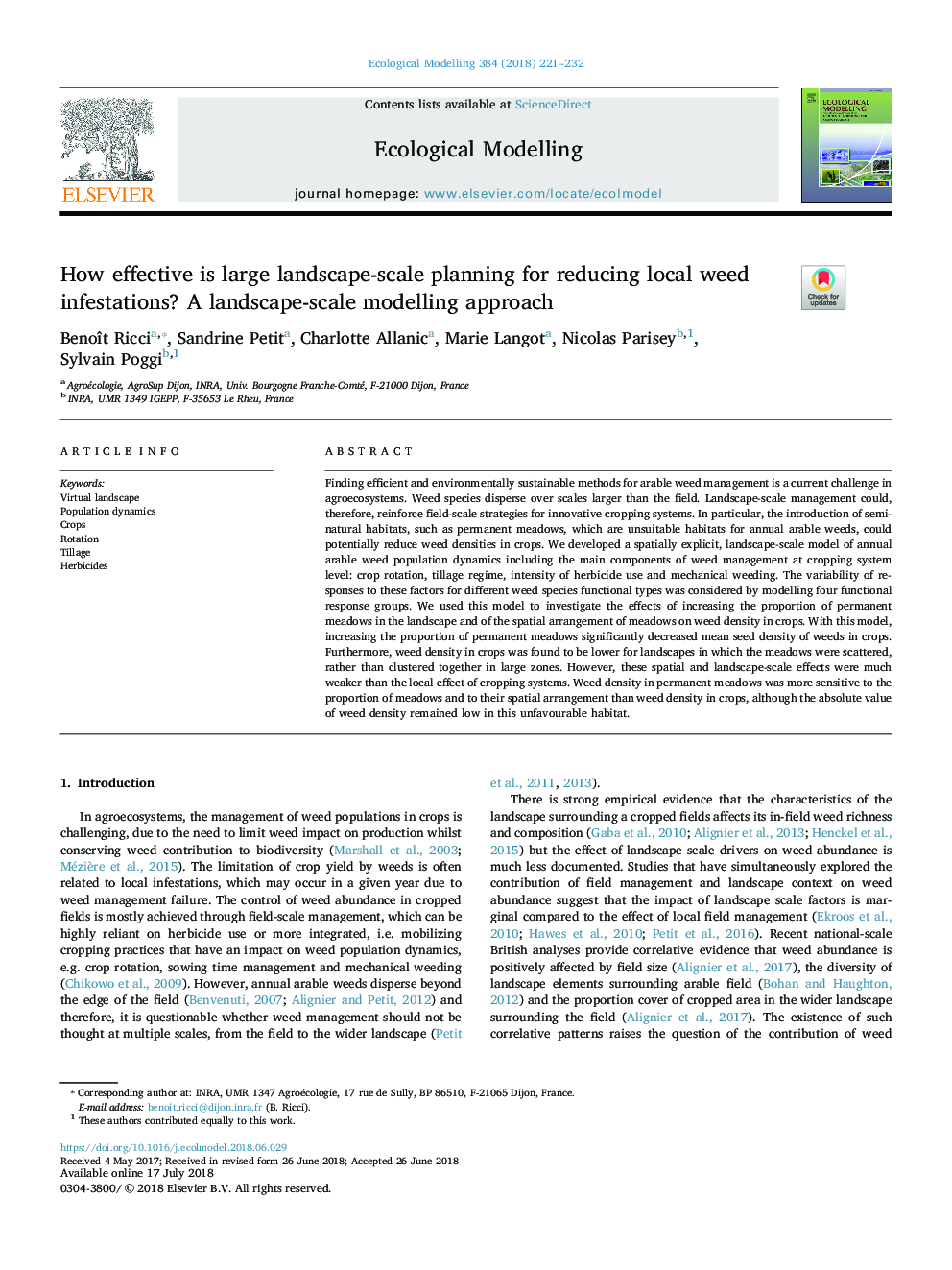| کد مقاله | کد نشریه | سال انتشار | مقاله انگلیسی | نسخه تمام متن |
|---|---|---|---|---|
| 8846002 | 1617363 | 2018 | 12 صفحه PDF | دانلود رایگان |
عنوان انگلیسی مقاله ISI
How effective is large landscape-scale planning for reducing local weed infestations? A landscape-scale modelling approach
ترجمه فارسی عنوان
چقدر برنامه ریزی چشمگیر در مقیاس بزرگ برای کاهش آلودگی علف های هرز موثر است؟ رویکرد مدل سازی چشم انداز در مقیاس
دانلود مقاله + سفارش ترجمه
دانلود مقاله ISI انگلیسی
رایگان برای ایرانیان
کلمات کلیدی
چشم انداز مجازی، دینامیک جمعیت، محصولات زراعی، چرخش کشت و زرع، علف کش ها،
ترجمه چکیده
پیدا کردن روش های کارآمد و محیط زیست پایدار برای مدیریت علف های هرز یک چالش فعلی در سیستم های کشاورزی است. گونه های علف های هرز در مقیاس بزرگتر از میدان پراکنده می شوند. بنابراین، مدیریت منظر در سطح چشم انداز می تواند راهکارهای مقدماتی را برای سیستم های کشت نوآورانه تقویت کند. به طور خاص، معرفی زیستگاه های نیمه طبیعی، مانند مراتع دائمی، که زیستگاه های نامناسب برای علف های هرز سالانه می باشد، می تواند به طور بالقوه تراکم علف های هرز را در محصولات کاهش دهد. ما یک مدل پراکندگی صریح و منظم از پوسته پوسته پوسته پوسته پوسته سالانه که شامل اجزای اصلی مدیریت علف های هرز در سطح سیستم کشت و زراعت می باشد، ایجاد گردید: چرخش محصول، رشوه دادن، شدت استفاده از علف کش و علف کش های مکانیکی. متغیر پاسخ به این عوامل برای انواع عملکردی علف های هرز توسط مدل سازی چهار گروه پاسخ عملکردی مورد بررسی قرار گرفت. ما از این مدل برای بررسی اثرات افزایش معادن روستاهای دائمی در منظر و آرایش فضایی چمنزار ها بر تراکم علف های هرز استفاده کردیم. با استفاده از این مدل، افزایش نسبت صخره های دائمی به طور معنی داری میانگین تراکم بذر علف های هرز در محصولات را کاهش داد. علاوه بر این، تراکم علف های هرز در محصولات، برای مناطق منزوی که در آن چمنزارها پراکنده شده اند، پایین تر است و نه به صورت خوشه ای در مناطق بزرگ. با این حال، این اثرات فضایی و چشم انداز در مقیاس بسیار ضعیف تر از اثر محلی سیستم های برداشت بود. تراکم علف های هرز در مراتع دائمی به نسبت صخره ها و آرایش فضایی آنها نسبت به تراکم علف های هرز در محصولات حساس تر بود، هرچند که ارزش مطلق تراکم علف های هرز در این زیستگاه نامطلوب باقی مانده است.
موضوعات مرتبط
علوم زیستی و بیوفناوری
علوم کشاورزی و بیولوژیک
بوم شناسی، تکامل، رفتار و سامانه شناسی
چکیده انگلیسی
Finding efficient and environmentally sustainable methods for arable weed management is a current challenge in agroecosystems. Weed species disperse over scales larger than the field. Landscape-scale management could, therefore, reinforce field-scale strategies for innovative cropping systems. In particular, the introduction of semi-natural habitats, such as permanent meadows, which are unsuitable habitats for annual arable weeds, could potentially reduce weed densities in crops. We developed a spatially explicit, landscape-scale model of annual arable weed population dynamics including the main components of weed management at cropping system level: crop rotation, tillage regime, intensity of herbicide use and mechanical weeding. The variability of responses to these factors for different weed species functional types was considered by modelling four functional response groups. We used this model to investigate the effects of increasing the proportion of permanent meadows in the landscape and of the spatial arrangement of meadows on weed density in crops. With this model, increasing the proportion of permanent meadows significantly decreased mean seed density of weeds in crops. Furthermore, weed density in crops was found to be lower for landscapes in which the meadows were scattered, rather than clustered together in large zones. However, these spatial and landscape-scale effects were much weaker than the local effect of cropping systems. Weed density in permanent meadows was more sensitive to the proportion of meadows and to their spatial arrangement than weed density in crops, although the absolute value of weed density remained low in this unfavourable habitat.
ناشر
Database: Elsevier - ScienceDirect (ساینس دایرکت)
Journal: Ecological Modelling - Volume 384, 24 September 2018, Pages 221-232
Journal: Ecological Modelling - Volume 384, 24 September 2018, Pages 221-232
نویسندگان
Benoît Ricci, Sandrine Petit, Charlotte Allanic, Marie Langot, Nicolas Parisey, Sylvain Poggi,
